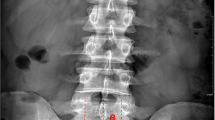Abstract
Aim
The previously suggested association between the incidence of high-level foot deformity and muscle imbalance is no longer supported, when evaluated independent from motor and sensory loss and level of lesion, by current studies. The purpose of this study was to evaluate the association between level of lesion and foot deformity.
Methods
Of 545 patients, a total of 136 (272 feet) patients admitted to the spina bifida clinic between 2010 and 2014 were included in this study. Levels of all lesions were evaluated using initial operation data, the motor-sensory exams, and direct radiography. All patients were categorized into four different groups: Thoracic region (group 1), high-level lumbar—L1-2 region (group 2), mild and lower lumbar regions (L3-4-5) (group 3), and Sacral region (group 4).
Results
The mean follow-up time was 34.9 months (range 8–176 months). Group 1, group 2, group 3, and group 4 included 24 (17.6 %), 14 (10.3 %), 19 (14 %), and 79 (58.1 %) patients with regards to level of lesion, respectively. The incidences of foot deformity were 85.4, 85.7, 81.5, and 50.6 % in groups 1, 2, 3, and 4, respectively. Of all patients, 22 % (61 feet) had clubfoot, 16 % (44 feet) pes cavus, 10 % (26 feet) pes valgus, 6 % (17 feet) isolated equinus, 6 % (17 feet) pes calcaneus, and 5 % (13 feet) metatarsus adductus. Patients without a foot deformity (81 % of normal feet) usually had a lesion at the sacral level (p ≤ 0.05). On the other hand, isolated equinus (70 %) and clubfoot (49 %) deformities were mostly observed in spinal lesions (p > 0.05). The incidence of pes calcaneus, pes valgus, and adductus deformities inclined as the lesion level decreased (p > 0.05).
Conclusion
In this study, it was concluded that foot deformities were directly related to the level of lesion. The comparison of higher and lower level lesions revealed that the types of foot deformity differed significantly. The muscle imbalance due to spina bifida was not sufficient to explain the pathology. On the other hand, the level of spinal lesion is an important factor for the type of deformity.


Similar content being viewed by others
References
Whittle, Michael W. Gait analysis: an introduction. 2003.
Broughton Nigel S, Geoffrey G, Menelaus MB (1994) The high incidence of foot deformity in patients with high-level spina bifida. J Bone & Joint Surgery, British 76(4):548–550
Dogan A, Albayrak M, Akman YE, Zorer G (2004) The results of calcaneal lengthening osteotomy for the treatment of flexible pes planovalgus and evaluation of alignment of the foot. Acta Orthop Traumatol Turc 40(5):356–366
Frawley PA, Broughton NS, Menelaus MB (1998) Incidence and type of hindfoot deformities in patients with low-level spina bifida. J Pediatr Orthop 18(3):312–313
Boulet SL, Gambrell D, Shin M, Honein MA, Mathews TJ (2009) Racial/ethnic differences in the birth prevalence of spina bifida—United States, 1995–2005. J Morb Mortal Wkly Rep 57(53):1409–1413
Çaglayan S, Kayhan B, Mentesoglu S,Aksit S;Changing incidence of neural tube defects in Aegean Turkey Paediatric and Perinatal Epidemiology Volume 3, Issue 1, pages 62–65, January 1989
BN French Midline fusion defects and defects of formation JR Youmans (Ed.), Neurological Surgery (2nd ed), W.B. Saunders, Philadelphia (1982), pp. 236–380 vol 3
Delpont, M., Lafosse, T., Bachy, M., Mary, P., Alves, A., & Vialle, R. (2014). [Congenital foot abnormalities.]. Archives de pediatrie: organe officiel de la Societe francaise de pediatrie.
Pediatric Orthopaedics: Core Knowledge In Orthopaedics; John P. Dormans, MD Philedelphia 2005 pp 492–493
Ömeroglu S, Peker T, Ömeroglu H, Gülekon N, Mungan T, Danisman N (2004) Intrauterine structure of foot muscles in talipes equinovarus due to high-level myelomeningocele: a light microscopic study in fetal cadavers. J Pediatr Orthop B 13(4):263–267
Frischhut B, Stöckl B, Landauer F, Krismer M, Menardi GJ (2000) Foot deformities in adolescents and young adults with spina bifida. Pediatr Orthop B 9(3):161–169
Flynn JM, Herrera-Soto JA, Ramirez NF, Fernandez-Feliberti R, Vilella F, Guzman J (2004) Clubfoot release in myelodysplasia. J Pediatr Orthop B 13:259–262. doi:10.1097/01.bpb.0000124491.13918.b7
Michael A, Bjoern B, Seyler TM, Wolfram W, Thomas B, Rainer A, Claus C (2009) Management of orthopaedic sequelae of congenital spinal disorders. J Bone Joint Surg Am 91(Supplement 6):87–100
Widhe T, Aaro SE, Elmstedt E (1988) Foot deformities in the newborn—incidence and prognosis. Acta Orthopaedica Scand 59:176–179
Widhe T, Foot Deformities at Birth (1997) A longitudinal prospective study over a 16-year period. J Pediatric Orthop Issue 17(1):20–24
Rodrigues RC, Dias LS (1992) Calcaneus deformity in spina bifida: results of anterolateral release. J Pediatr Orthop 12(4):461–464. doi:10.1097/01241398-199207000-00008
Park KB, Park HW, Joo SY, Kim HW (2008) Surgical treatment of calcaneal deformity in a select group of patients with myelomeningocele. J Bone Joint Surg Am 90(10):2149–2159
Erşahin Y (2013) Split cord malformation types I and II: a personal series of 131 patients. Childs Nerv Syst 29(9):1515–1526
Author information
Authors and Affiliations
Corresponding author
Ethics declarations
Conflict of interest
Each author certifies that he or she, or a member of his or her immediate family, has no funding or commercial associations (e.g., consultancies, stock ownership, equity interest, patent/licensing arrangements, etc.) that might pose a conflict of interest in connection with the submitted article.
Rights and permissions
About this article
Cite this article
Gunay, H., Sozbilen, M.C., Gurbuz, Y. et al. Incidence and type of foot deformities in patients with spina bifida according to level of lesion. Childs Nerv Syst 32, 315–319 (2016). https://doi.org/10.1007/s00381-015-2944-7
Received:
Accepted:
Published:
Issue Date:
DOI: https://doi.org/10.1007/s00381-015-2944-7




